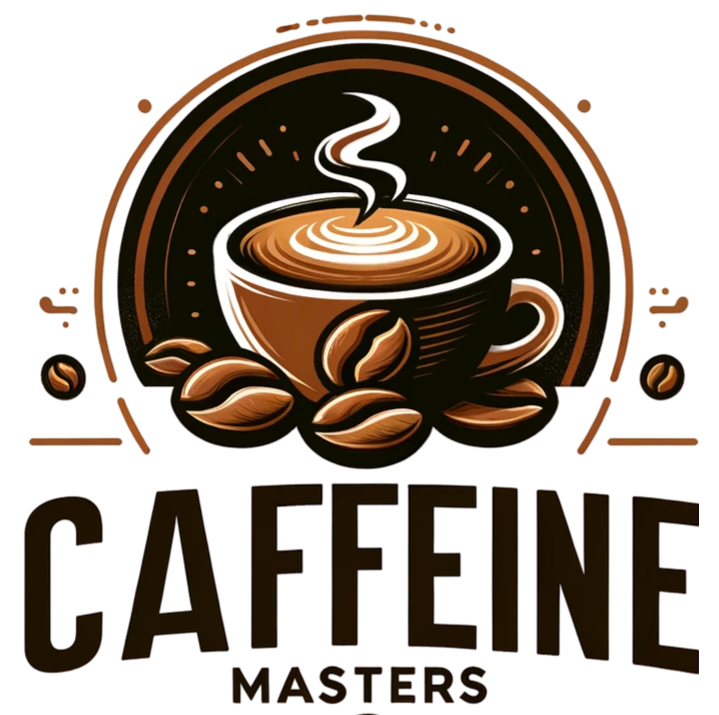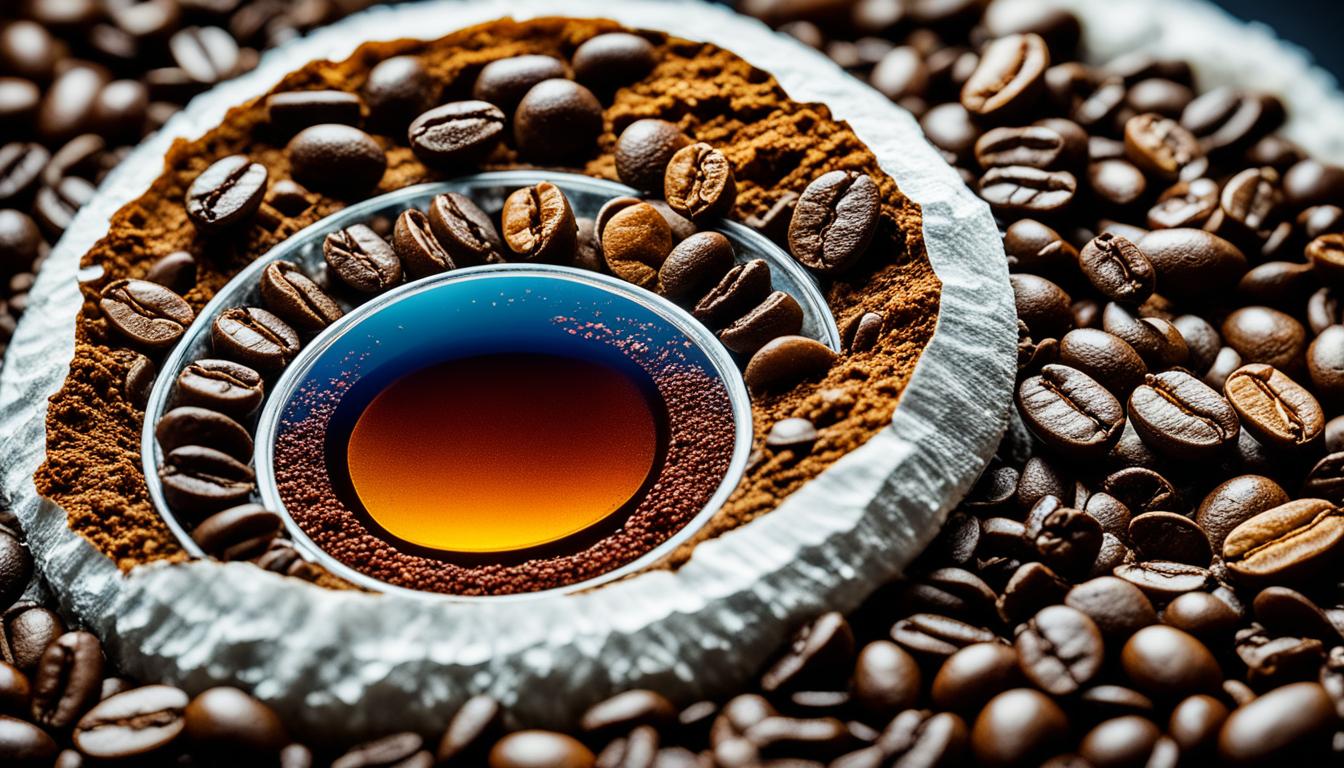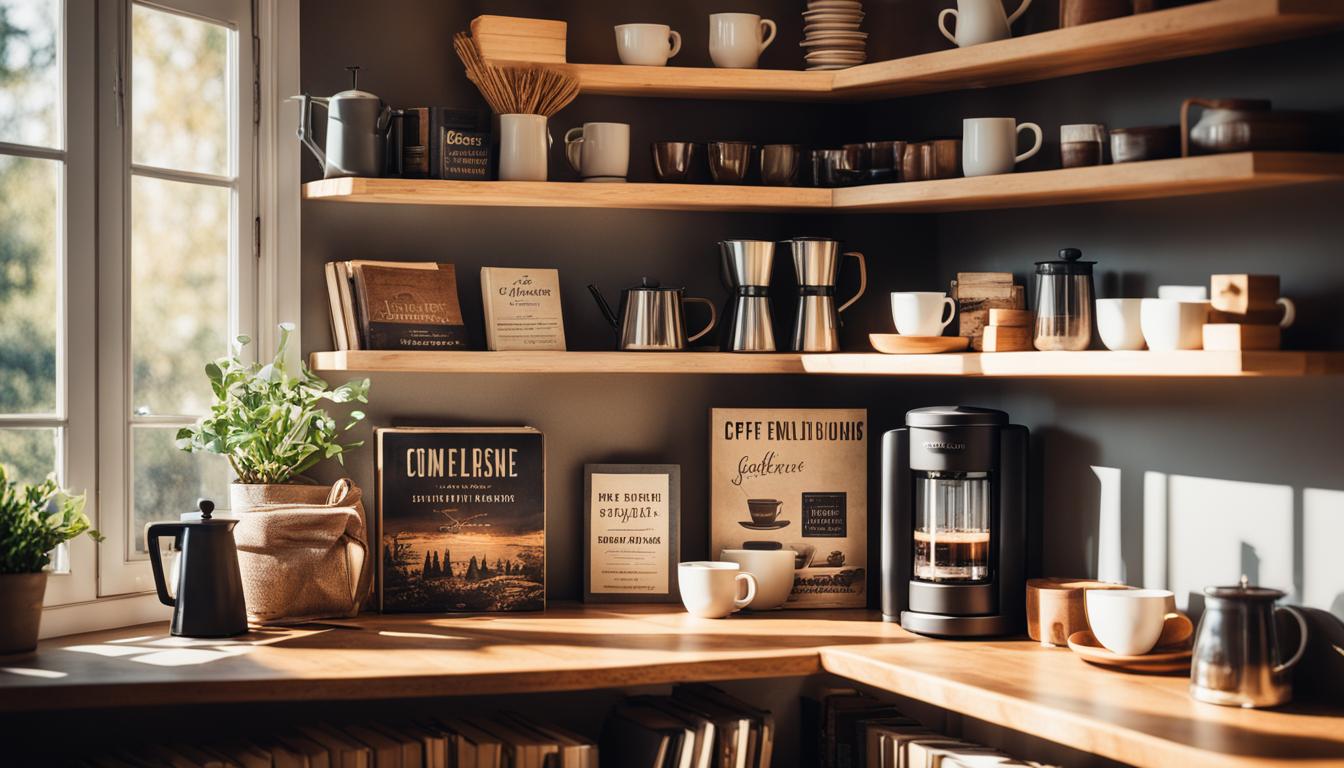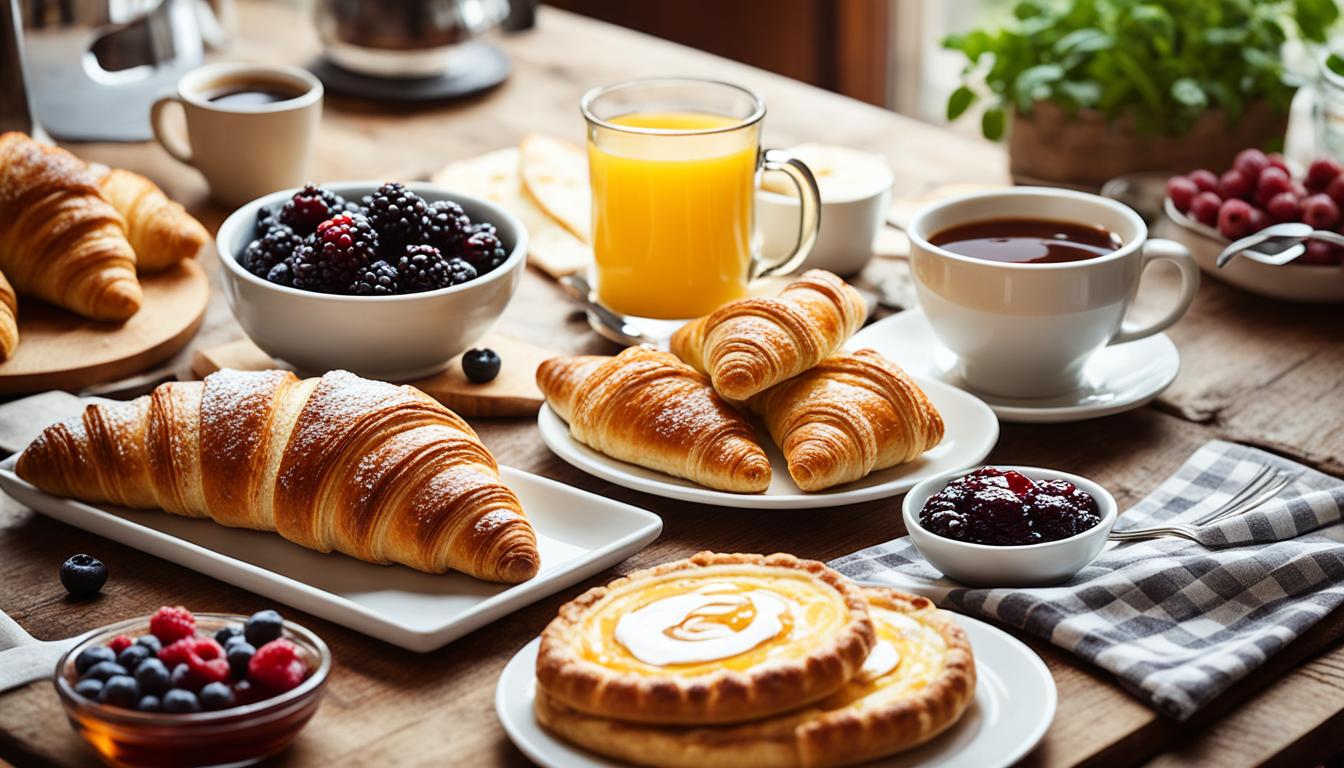Welcome to our journey deep into the fascinating world of coffee extraction! In this article, we will explore the scientific principles that underpin the art of coffee brewing. Understanding the science of coffee extraction is the key to unlocking the perfect cup of joe every time.
Have you ever wondered why some cups of coffee taste bland or bitter while others are bursting with rich flavors and enticing aromas? The secret lies in the intricate process of coffee extraction, where water extracts the soluble compounds from ground coffee beans to create the brew we know and love.
Join us as we delve into the importance of coffee extraction and the factors that influence it. Together, we will uncover the optimal extraction parameters and techniques that will enable you to elevate your coffee brewing skills to new heights.
Key Takeaways:
- Understanding the science of coffee extraction is essential for brewing a delicious cup of coffee.
- Coffee extraction parameters like water temperature, grind size, brewing time, and coffee-to-water ratio significantly impact the flavor and quality of the final brew.
- There are various coffee extraction methods, including drip brewing, espresso, French press, and pour-over, each with its unique characteristics and extraction principles.
- Mastering coffee extraction techniques like pre-infusion and agitation can optimize extraction efficiency and enhance flavor.
- Specialty coffee requires a meticulous approach to extraction, considering precise parameters, roast profiles, and tasting notes to unlock its unique flavors.
The Importance of Coffee Extraction
Understanding the importance of coffee extraction is crucial for achieving a delicious cup of coffee. Every coffee lover knows that the flavor, aroma, and body of the final brew greatly depend on the extraction process. So, let’s dive into the fascinating world of coffee extraction and uncover why it plays such a vital role in unlocking the desired flavors from the coffee beans.
When coffee grounds come into contact with hot water during the brewing process, a complex chemical reaction takes place. This reaction extracts the soluble compounds from the coffee beans, including the rich oils, sugars, and acids that give coffee its distinctive taste and aroma. However, the extraction process is not as simple as it may seem. It involves various stages that require careful attention to detail to achieve optimal results.
To grasp the importance of coffee extraction, we need to understand the concept of extraction yield. This refers to the percentage of soluble compounds extracted from the coffee grounds in relation to the total amount available. The extraction yield directly affects the strength and flavors of the final brew. A well-extracted coffee will have balanced flavors, while under-extraction results in a weak and sour taste, and over-extraction leads to bitterness.
Let’s take a closer look at the different stages of the coffee extraction process:
- Wetting: As hot water comes in contact with the coffee grounds, it wets and saturates them, allowing the extraction process to begin.
- Dissolution: In this stage, the soluble compounds start dissolving into the water, including the desirable flavors we seek in our cup of coffee.
- Diffusion: The dissolved compounds gradually travel from the coffee grounds to the surrounding water, spreading their flavors and aromas.
- Equilibrium: This stage occurs when the extraction process reaches a point where the water has absorbed as many soluble compounds as it can. At this point, continuing the extraction will lead to over-extraction and unwanted flavors.
Understanding the importance of coffee extraction is like uncovering the secret language of your favorite coffee beans. Each stage of the process contributes to the final brew, delicate flavors dancing on your taste buds with every sip. Now, let’s explore the finer details of extraction parameters and the methods to unlock the true potential of your coffee.
To illustrate the significance of extraction, let’s explore a visual representation:
| Extraction Level | Description | Impact on Flavor |
|---|---|---|
| Under-extraction | Insufficient extraction of soluble compounds | Weak, sour, and lacking flavor |
| Optimal extraction | Effective extraction of balanced flavors | Full-bodied, flavorful, and aromatic |
| Over-extraction | Excessive extraction, resulting in bitter flavors | Bitter, harsh, and unpleasant taste |
As you can see, achieving the perfect balance of extraction is paramount to enjoying a flavorful cup of coffee. By understanding the extraction process and its impact on flavor, aroma, and body, you can fine-tune your brewing techniques to unlock the full potential of your favorite coffee beans.
Coffee Extraction Parameters
When brewing coffee, it’s not just the quality of the beans that matters. The parameters we set during the extraction process have a significant impact on the taste and quality of our cup of joe. Let’s delve into the essential coffee extraction parameters and how each one influences the extraction process.
Water Temperature
The temperature of the water used for coffee extraction plays a crucial role in determining the flavors extracted from the beans. Generally, a water temperature between 195°F and 205°F (90°C to 96°C) is considered optimal for most coffee brewing methods. Hotter water can lead to over-extraction, resulting in a bitter taste, while cooler water may result in under-extraction, leading to a weak and sour brew.
Grind Size
The grind size of the coffee beans affects the rate at which extraction takes place. Finely ground coffee allows for faster extraction, while coarser grinds take longer. Each brewing method requires a specific grind size for optimal extraction. For example, espresso calls for fine grounds, while French press requires a coarser grind. Experimenting with different grind sizes can help you find the perfect balance of flavors.
Brewing Time
The brewing time, or the duration for which water comes in contact with the coffee grounds, influences the extraction process. Longer brew times generally lead to a more extracted, stronger cup of coffee, while shorter brew times result in lighter, milder flavors. The ideal brewing time varies depending on the brewing method and personal preference.
Coffee-to-Water Ratio
The ratio of coffee to water used in the brewing process is another critical parameter. The coffee-to-water ratio determines the strength and intensity of the final brew. A higher coffee-to-water ratio yields a stronger cup of coffee, while a lower ratio results in a milder taste. Finding the perfect balance depends on your individual preferences and the flavors you wish to extract.
By understanding and optimizing these coffee extraction parameters, you can fine-tune your brewing technique to achieve a balanced and flavorful cup of coffee. Experiment with various combinations to discover your favorite taste profile.

Coffee Extraction Methods
When it comes to coffee extraction, there is no one-size-fits-all approach. Different methods yield different results, each with its own unique characteristics and flavors. In this section, we will explore four popular coffee extraction methods and provide insights into their extraction principles, tips for maximizing flavor, and guidance on choosing the best method for your coffee preferences.
Drip Brewing
Drip brewing is a classic coffee extraction method that involves pouring hot water over coffee grounds placed in a filter. This method allows for a controlled and gradual extraction, resulting in a clean and balanced cup of coffee. The main advantage of drip brewing is its convenience, as automatic drip coffee makers are widely available. However, manual pour-over techniques using a drip cone or V60 can also be employed for more precision and customization.
Key characteristics of drip brewing:
- Consistent and reliable extraction
- Medium body and moderate acidity
- Clear flavors with a well-rounded profile
To achieve the best results with drip brewing, use a medium grind size, maintain an appropriate water temperature (around 195-205°F), and adjust the coffee-to-water ratio to your taste preference.
Espresso
Espresso is a highly concentrated extraction method that produces a bold and intense coffee experience. It involves forcing pressurized hot water through finely ground coffee under high pressure, resulting in a rich and flavorful shot of espresso. This method is the foundation for popular coffee-based beverages such as cappuccinos and lattes.
Key characteristics of espresso:
- Full-bodied and strong flavor
- Crema, a layer of foam on top, adds complexity
- Typically consumed in small, concentrated servings
To achieve a successful espresso extraction, it is crucial to have a consistent grind size, proper tamping technique, and precise brewing parameters, including water temperature (around 195-205°F) and extraction time.
French Press
The French press method, also known as a press pot or plunger pot, offers a full-bodied and robust coffee experience. It involves steeping coarsely ground coffee in hot water for several minutes and then separating the brewed coffee from the grounds using a mesh plunger.
Key characteristics of French press:
- Strong flavor with rich oils and sediment
- Full-bodied and heavy mouthfeel
- Flexible and forgiving brewing process
To achieve optimal results with a French press, use a coarse grind size, allow for a longer steeping time (around 4-5 minutes), and filter the brewed coffee carefully to minimize sediment.
Pour-Over
Pour-over is a manual brewing method that emphasizes precision and control. It involves pouring hot water over a bed of coffee grounds in a steady and circular motion, allowing the water to extract the desired flavors. The slow and deliberate process of pour-over brewing allows for a nuanced and delicate cup of coffee.
Key characteristics of pour-over:
- Clean and bright flavors with pronounced acidity
- Light to medium body
- Customizable and adjustable brewing process
To achieve the best pour-over extraction, use a medium-fine grind size, maintain a consistent water temperature (around 195-205°F), and experiment with different pouring techniques to find your preferred flavor profile.
Now that you have explored these different coffee extraction methods, it’s time to experiment and find the one that suits your taste preferences and brewing style. Let’s unlock the full potential of your coffee brewing journey!
| Extraction Method | Characteristics |
|---|---|
| Drip Brewing | Consistent and balanced extraction |
| Espresso | Intense and full-bodied flavor |
| French Press | Robust and heavy mouthfeel |
| Pour-Over | Clean and bright flavors with pronounced acidity |
Best Coffee Extraction Techniques
Unlocking the full flavor potential of your coffee requires mastering the art of extraction. In this section, we will share expert tips and techniques to optimize your coffee extraction process and achieve a consistently excellent cup of coffee. From pre-infusion techniques to agitation methods, we will explore different approaches that can enhance extraction efficiency and bring out the best flavors in your brew.
Pre-infusion
Pre-infusion is a technique that involves saturating the coffee grounds with a small amount of water before the main extraction begins. This allows for a more uniform extraction and helps to release trapped gases within the coffee grounds. To implement pre-infusion, pour a small amount of hot water over the coffee grounds, let it sit for about 30 seconds, and then begin the regular brewing process.
Agitation Methods
Agitation plays a crucial role in coffee extraction. By gently stirring or shaking the coffee bed during the brewing process, you can ensure that all the coffee grounds are evenly saturated and promote a more thorough extraction. Experiment with stirring gently with a wooden spoon or giving your brewing device a gentle swirl to enhance extraction.
Temperature Control
The temperature of the water used for brewing directly impacts the extraction process. For optimal extraction, maintain a water temperature between 195°F and 205°F (90°C and 96°C). Use a digital thermometer to monitor the water temperature and make adjustments as necessary to achieve the desired range.
Grind Size
The grind size of your coffee beans has a significant impact on extraction. Finer grind sizes extract more quickly, while coarser grind sizes extract more slowly. Adjust the grind size based on your desired brewing method to achieve the ideal balance between extraction time and flavor.
Brewing Time
Controlling the brewing time is essential for optimal extraction. Different brewing methods require different brewing times, so follow the recommendations specific to your chosen method. Too short of a brewing time can result in under-extraction, while a prolonged brewing time can lead to over-extraction and a bitter taste.
Water-to-Coffee Ratio
The ratio of water to coffee grounds is vital for achieving a balanced extraction. A general guideline is to use a ratio of 1:16, which means one part coffee to 16 parts water. However, feel free to adjust the ratio based on personal preference and desired strength of the brew.
“Optimizing coffee extraction techniques is key to unlocking the rich flavors and complexities hidden within every coffee bean.”
To summarize, optimizing coffee extraction techniques involves pre-infusion, agitation methods, temperature control, adjusting grind size, managing brewing time, and maintaining the right water-to-coffee ratio. By implementing these techniques, you can elevate your coffee brewing skills and unlock a truly exceptional cup of coffee.
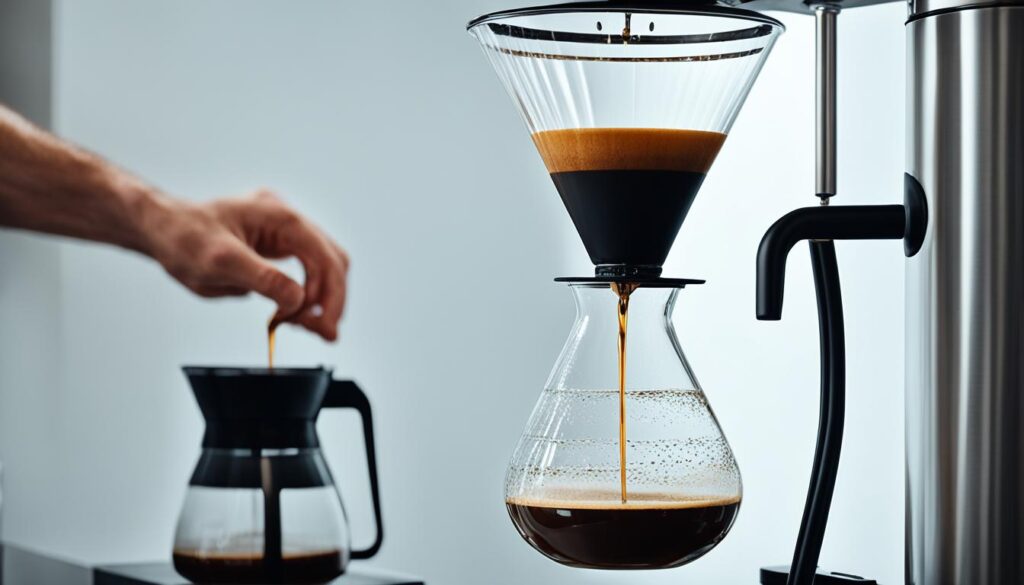
Specialty Coffee Extraction
When it comes to specialty coffee, exceptional flavor profiles are the name of the game. To truly savor the nuances and complexities of specialty coffee, an artful and meticulous approach to extraction is required. In this section, we will explore the intricacies of brewing specialty coffee and uncover the secrets to unlocking extraordinary flavors in every sip.
One of the pillars of specialty coffee extraction is precision. Every parameter, from water temperature to brew time, must be carefully measured and adjusted to perfection. By maintaining precise extraction parameters, you can ensure that the flavors inherent in the beans are fully extracted, resulting in a rich and balanced cup.
Understanding roast profiles is another crucial aspect of specialty coffee extraction. Different coffee beans undergo various roasting techniques that influence their flavor characteristics. Lighter roasts may have vibrant and delicate flavors, while darker roasts may exhibit bolder and more robust notes. By grasping the nuances of roast profiles, you can tailor your extraction methods to bring out the best in each coffee bean.
One of the joys of specialty coffee is the ability to appreciate specific tasting notes. Just like a fine wine, specialty coffees often come with detailed descriptions of their taste profiles. From fruity and floral to nutty and chocolatey, each coffee offers a unique sensory experience. By understanding the tasting notes associated with different coffees, you can adjust your extraction parameters to highlight specific flavors and create a truly customized coffee experience.
Ready to elevate your specialty coffee brewing skills? Let’s explore the world of specialty coffee extraction together and unlock extraordinary flavors in every cup.
Specialty Coffee Extraction Parameters
When brewing specialty coffee, precision is key. Here are some essential extraction parameters to focus on:
| Parameter | Importance |
|---|---|
| Water Temperature | Optimal temperature allows for proper extraction of flavors without scorching the beans. |
| Grind Size | The right grind size ensures the ideal surface area for extraction, influencing the overall flavor and strength of the coffee. |
| Brewing Time | Controlling the brewing time contributes to the balance of flavors and prevents over or under-extraction. |
| Coffee-to-Water Ratio | Achieving the perfect ratio of coffee to water influences the strength and concentration of the brew. |
By mastering these extraction parameters, you can extract the full potential of specialty coffee and enjoy its extraordinary flavors.
Conclusion
Throughout this article, we have explored the science of coffee extraction and how it influences the taste and quality of our favorite beverage. By understanding the key factors, techniques, and parameters involved in coffee extraction, you can take your brewing skills to new heights.
So, grab your favorite coffee beans, apply what you’ve learned, and embark on a journey to unlock the full potential of your daily cup of coffee. Experiment with different extraction methods, adjust the parameters to suit your preferences, and savor the delightful nuances of each brew.
Coffee extraction is a true art, and with practice, you’ll become a master of extracting the perfect cup every time. Whether you’re a coffee enthusiast or a professional barista, the knowledge gained from this article will empower you to create exceptional coffee experiences for yourself and others.
Cheers to the science of coffee extraction! Let the aroma, flavors, and joy of a well-brewed cup brighten each day and bring people together over the love of coffee.
FAQ
What is coffee extraction?
Coffee extraction is the process of dissolving and extracting flavor compounds from ground coffee beans using water. It is the crucial step in brewing coffee and involves the transfer of desirable compounds, such as acids, oils, and sugars, into the final cup.
Why is coffee extraction important?
Coffee extraction is important because it directly affects the flavor, aroma, and body of the final brew. Proper extraction ensures a well-balanced and delicious cup of coffee by extracting the desired flavors while avoiding excessive bitterness or sourness from under or over-extraction.
What are the key factors that affect coffee extraction?
Several factors influence coffee extraction, including grind size, brewing time, water temperature, and coffee-to-water ratio. Each of these parameters contributes to the extraction process and plays a role in achieving the desired flavors in the final cup.
How can I optimize coffee extraction?
To optimize coffee extraction, you can focus on adjusting the key parameters. Experiment with different grind sizes, brewing times, water temperatures, and coffee-to-water ratios until you find the optimal combination for your preferred taste. Fine-tuning these variables can enhance the extraction process and result in a more flavorful and balanced cup of coffee.
What are the different coffee extraction methods?
There are various coffee extraction methods, including drip brewing, espresso, French press, and pour-over. Each method has its unique characteristics and extraction principles, which affect the flavor profile of the coffee. Choosing the right extraction method depends on your personal preferences and the desired brewing experience.
What are the best techniques for coffee extraction?
Some of the best coffee extraction techniques include pre-infusion, agitation methods, and controlling variables such as water temperature and grind size. These techniques can optimize the extraction process and help achieve a more desirable and consistent cup of coffee.
How does specialty coffee extraction differ?
Specialty coffee extraction requires extra attention to detail. Understanding the precise extraction parameters, roast profiles, and specific tasting notes is essential. Specialty coffee beans often have distinct flavor profiles, and optimizing the extraction process allows you to fully appreciate their unique characteristics.
